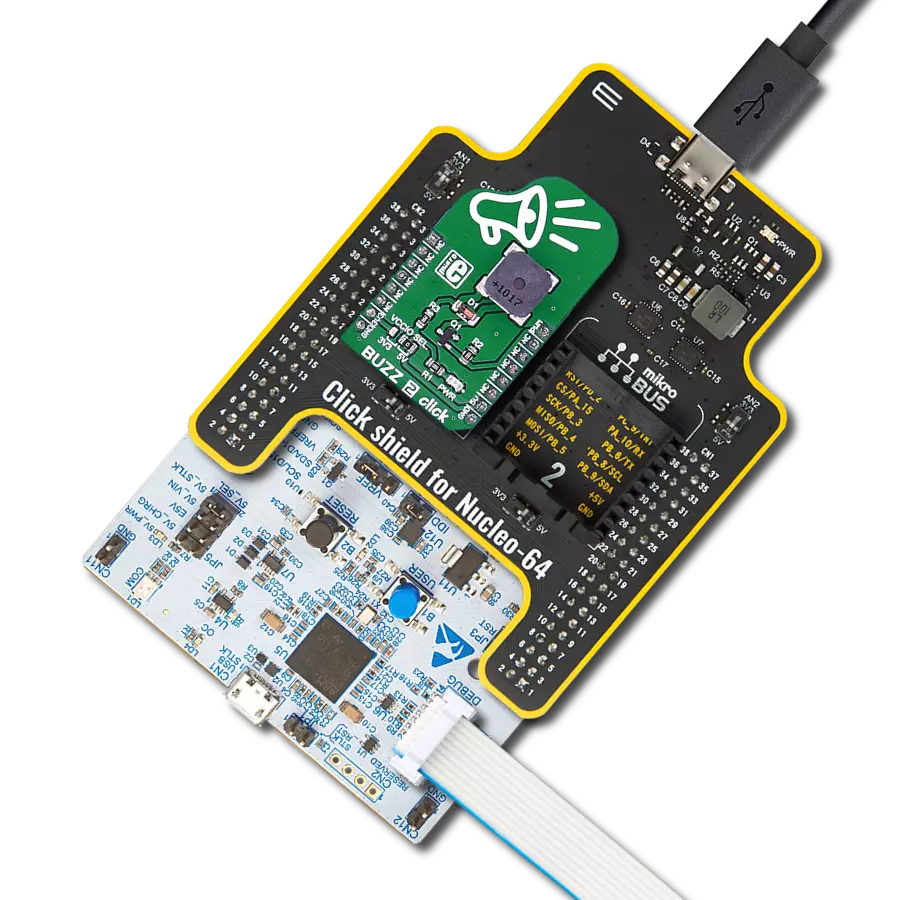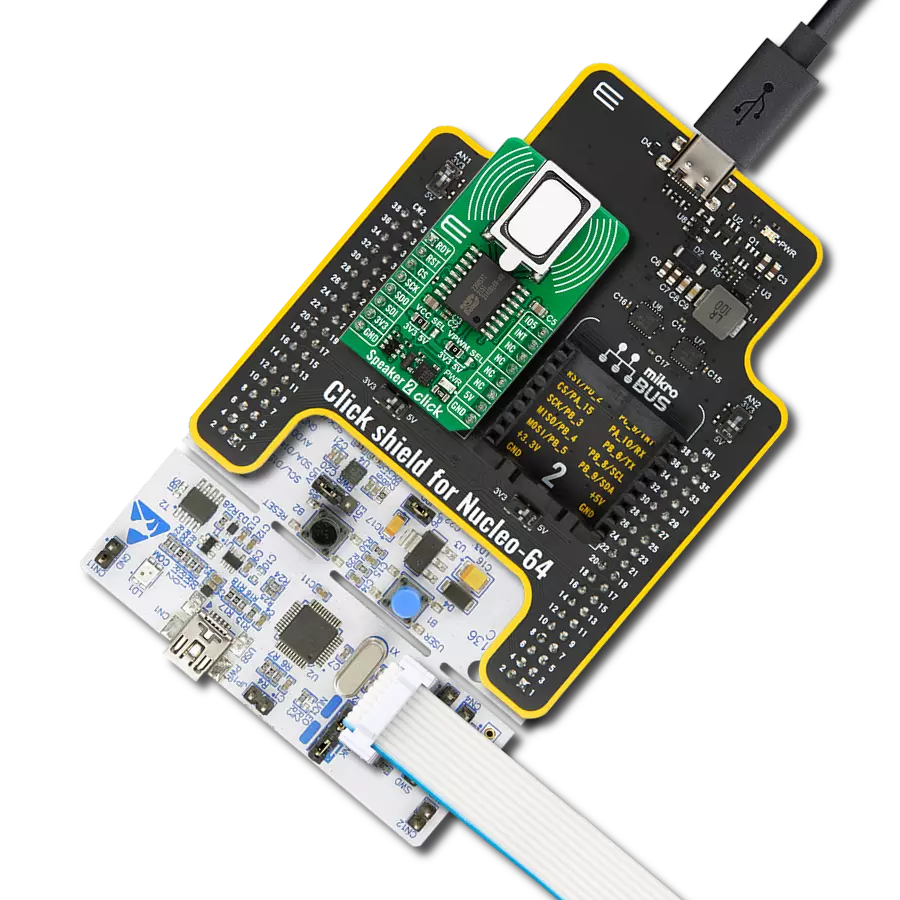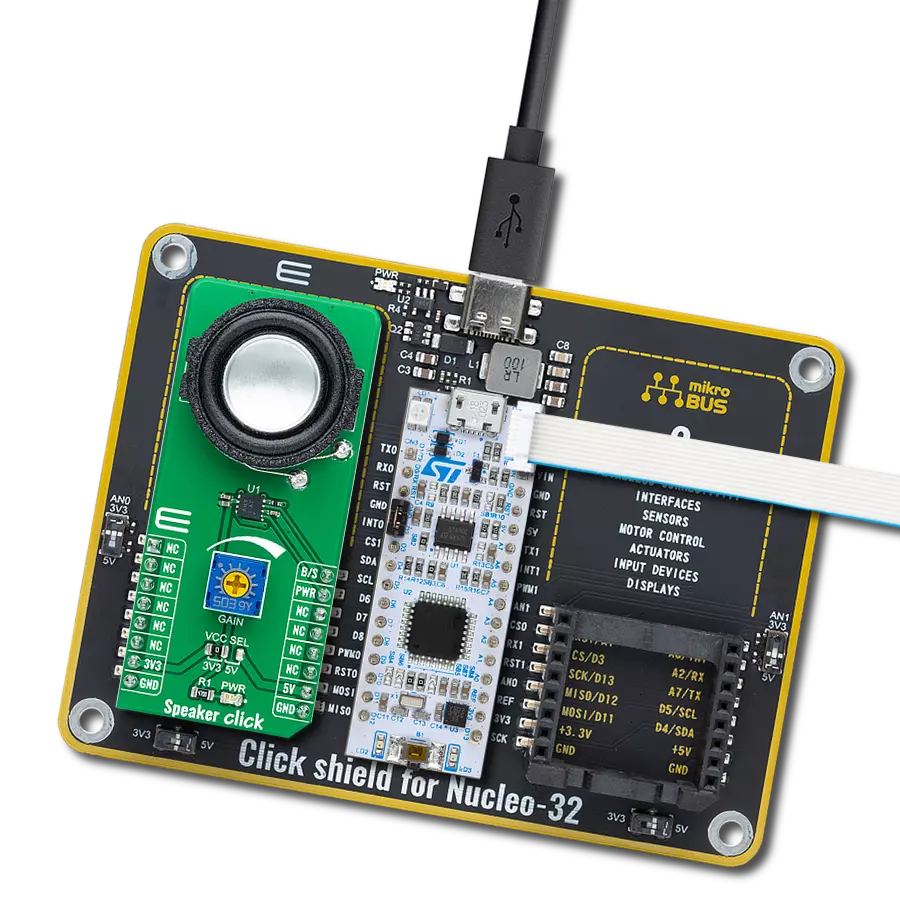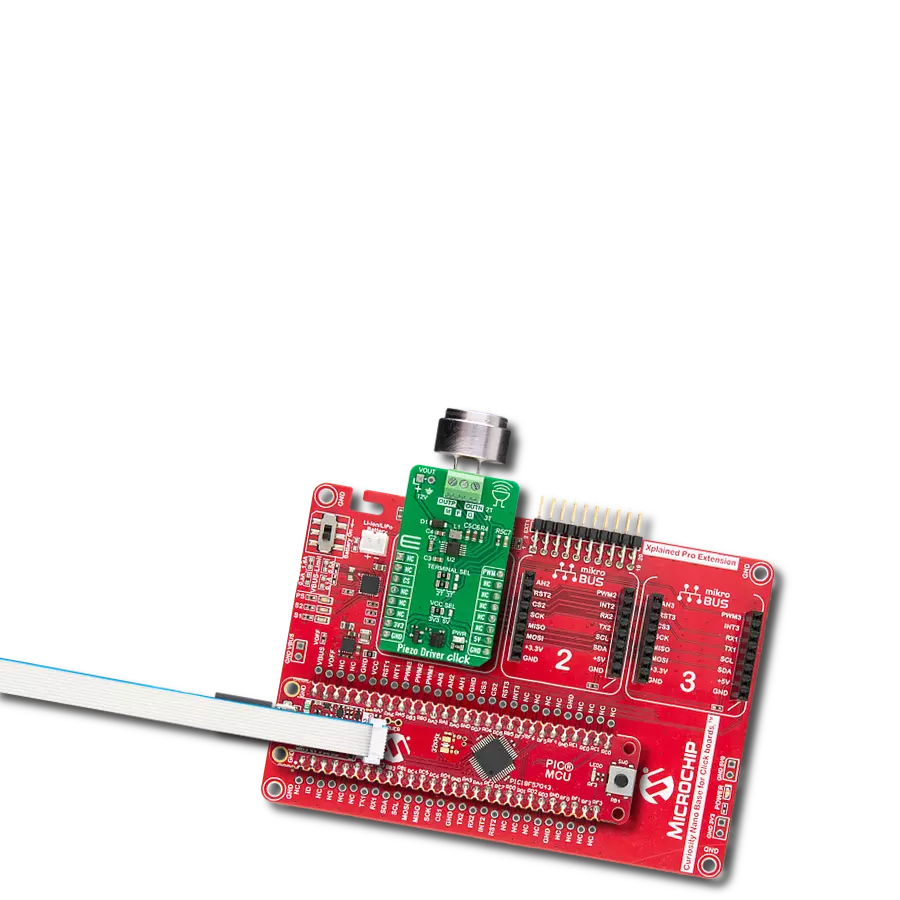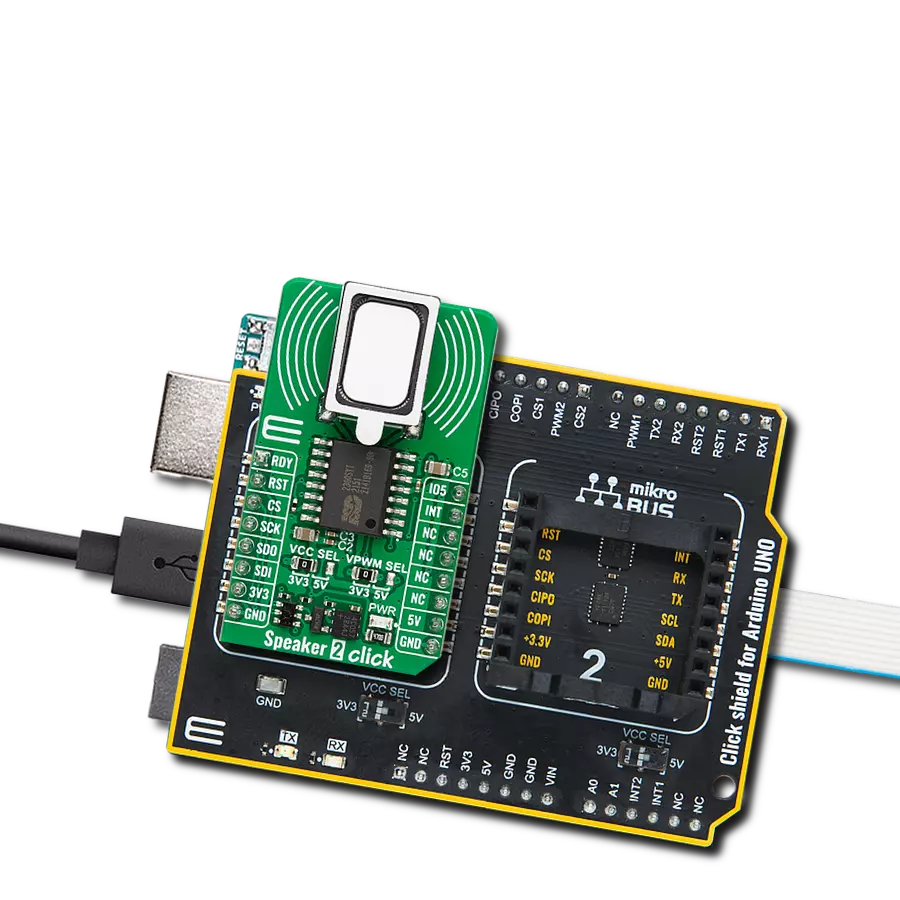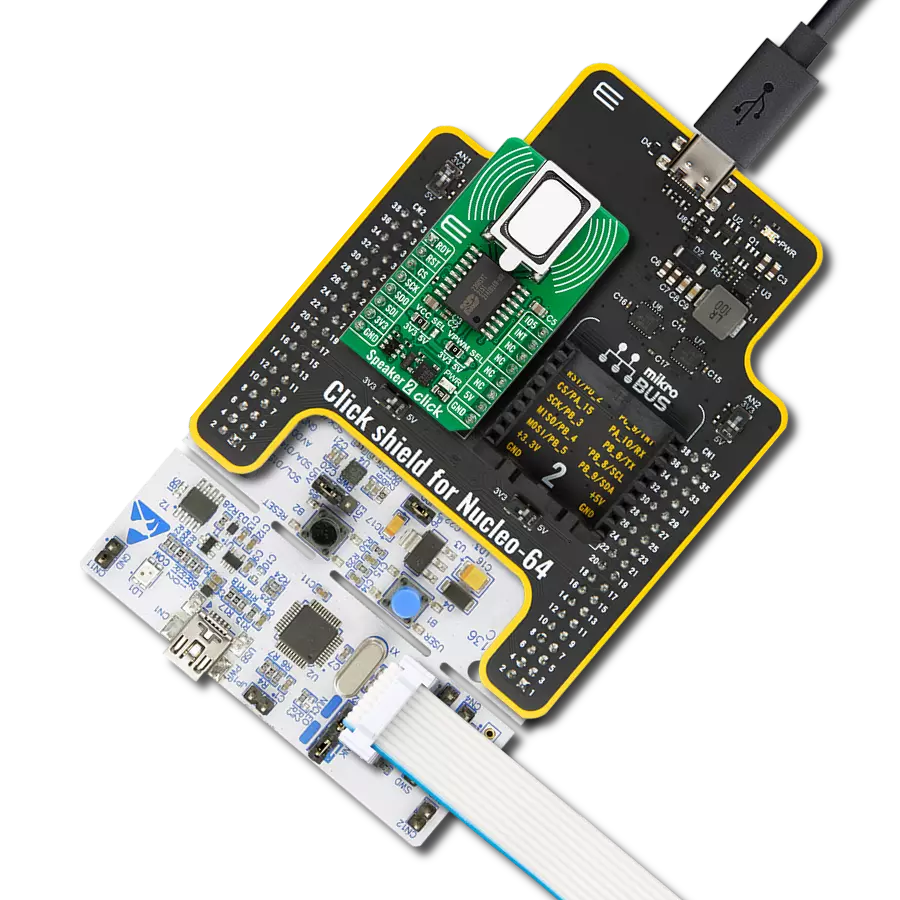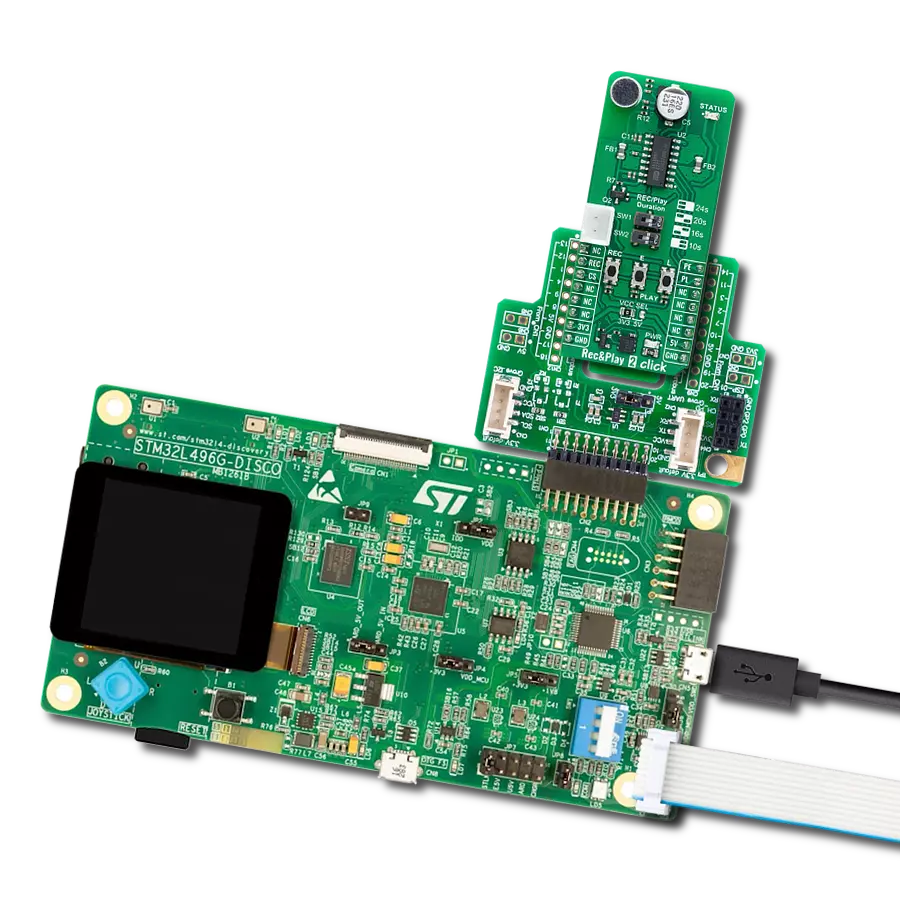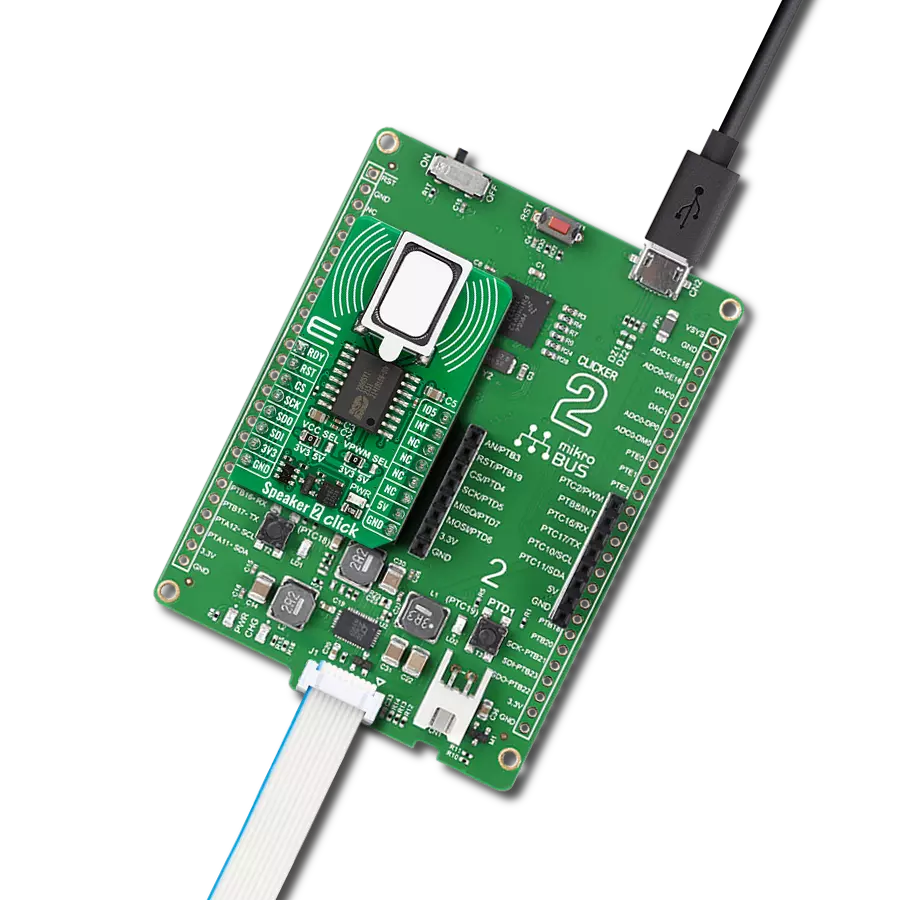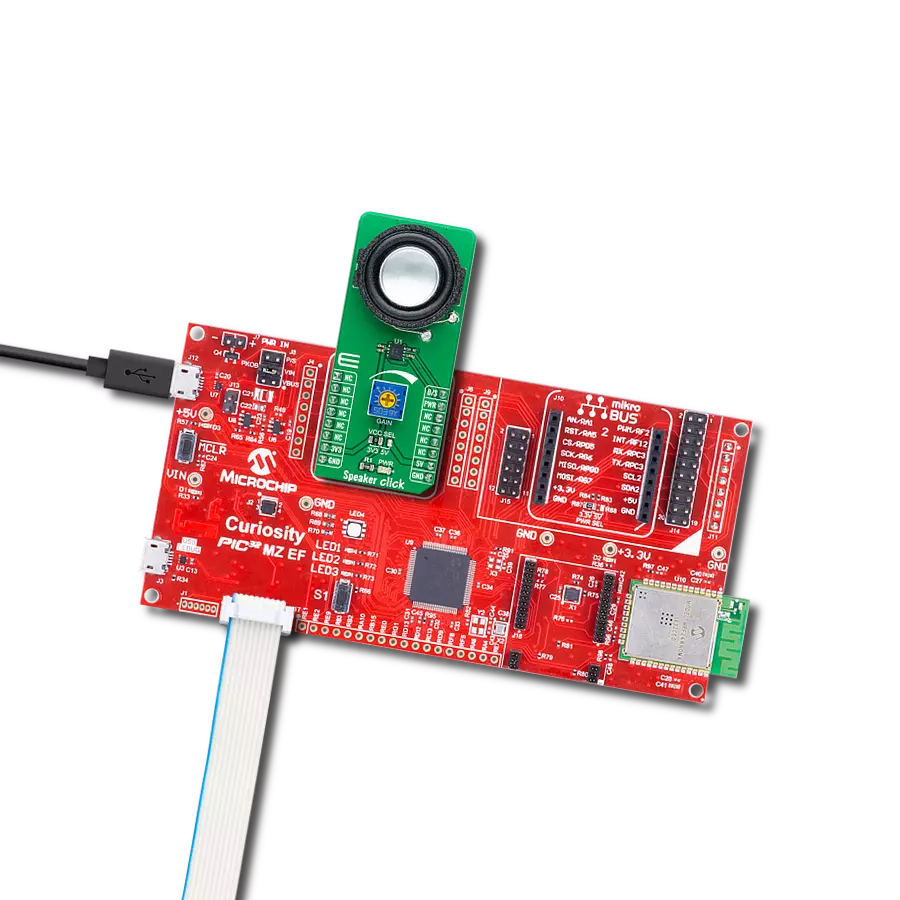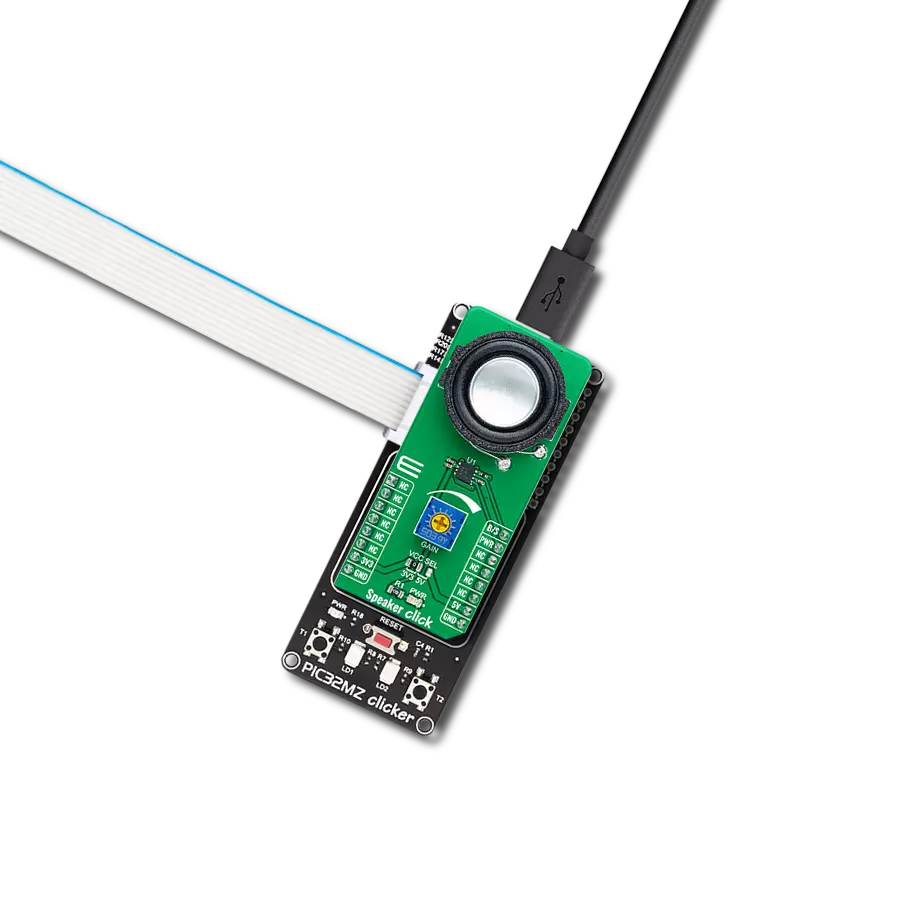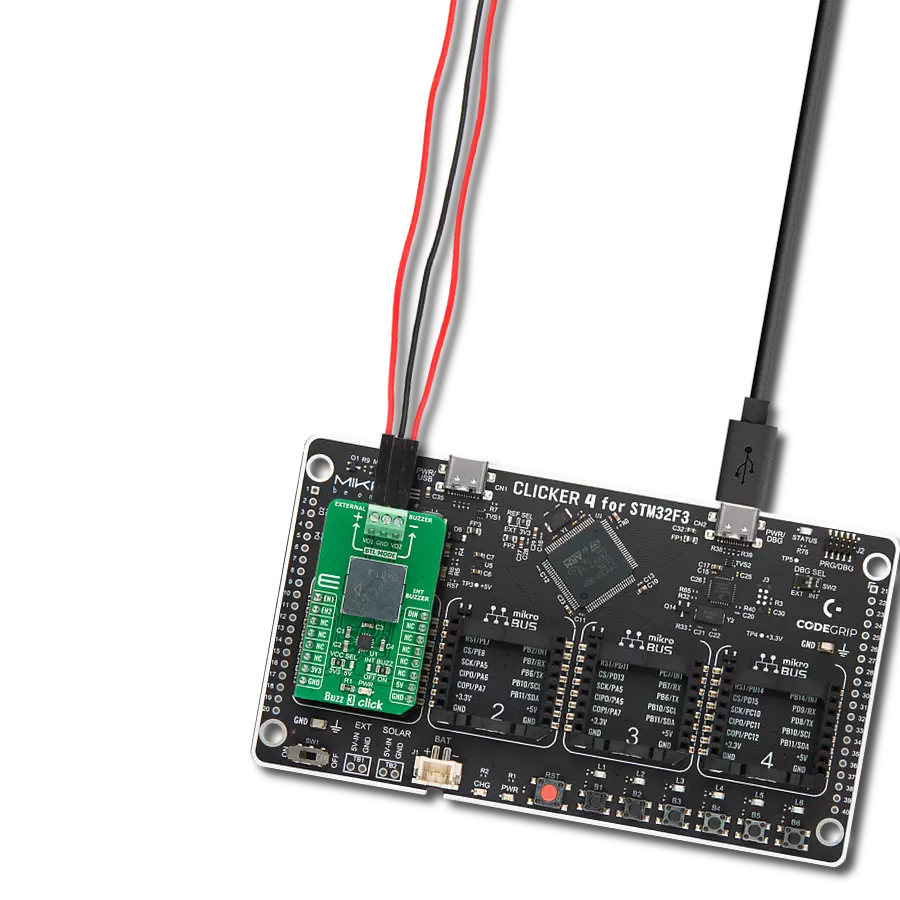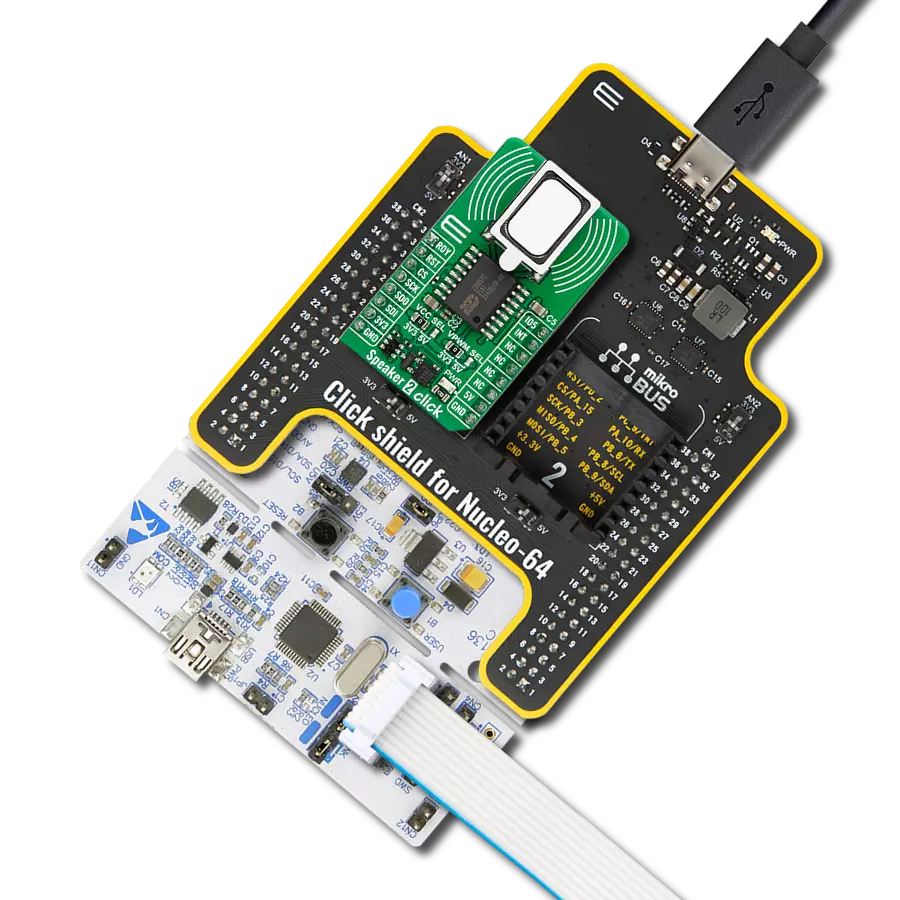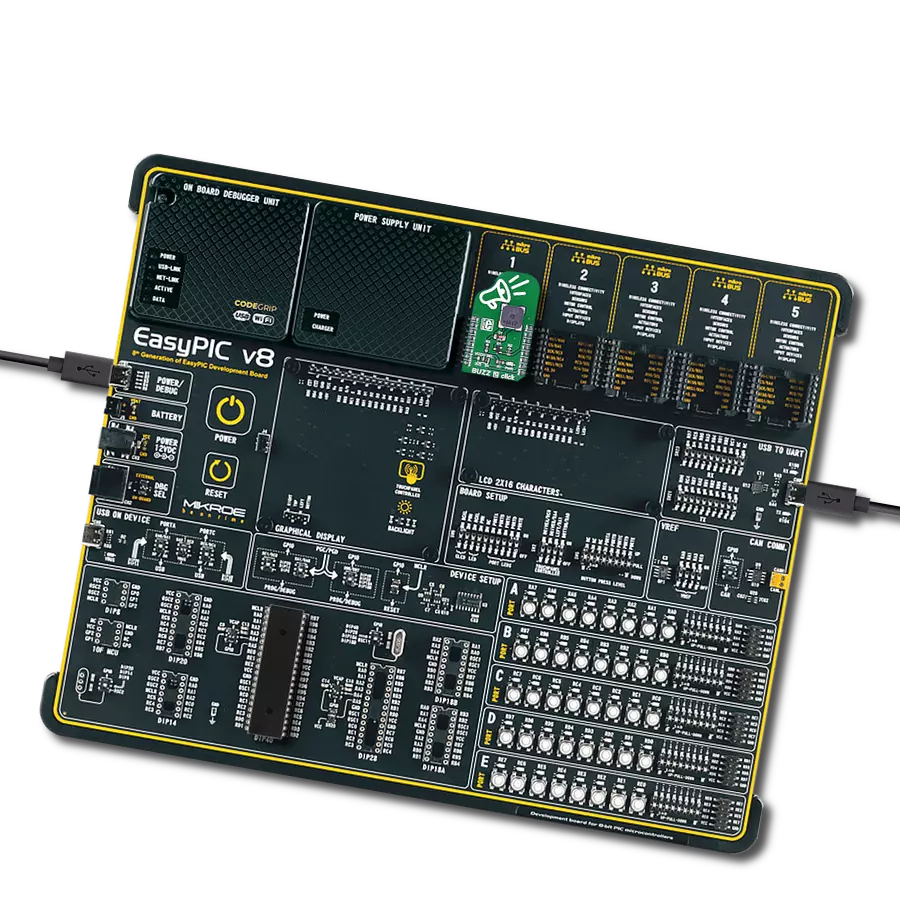Convert electrical energy into mechanical vibrations and produce audible sound waves
A
A
Hardware Overview
How does it work?
Piezo Driver Click is based on the PAM8906, a piezo sounder driver with self-excitation mode from Diodes Incorporated. It features automatic shutdown and wake-up control, low operating current, very short turn ON/OFF, over-voltage protection, over-current protection, and more. This driver operates with an external PWM input. It can drive a two-terminal or three-terminal piezo sounder, and selection can be made over the
TERMINAL SEL jumper. The piezo sounder can be connected over the 3-pin screw terminal, labeled differently for both available options. In addition, you can use VOUT to power up the piezo sounder. Piezo Driver Click uses a PWM input pin to communicate with the host MCU. The PWM input will be amplified and driven to the output terminal if used as an external PWM control. It can also be used for automatic wake-up and shutdown
control. This Click board™ can operate with either 3.3V or 5V logic voltage levels selected via the VCC SEL jumper. This way, both 3.3V and 5V capable MCUs can use the communication lines properly. Also, this Click board™ comes equipped with a library containing easy-to-use functions and an example code that can be used as a reference for further development.
Features overview
Development board
Arduino UNO is a versatile microcontroller board built around the ATmega328P chip. It offers extensive connectivity options for various projects, featuring 14 digital input/output pins, six of which are PWM-capable, along with six analog inputs. Its core components include a 16MHz ceramic resonator, a USB connection, a power jack, an
ICSP header, and a reset button, providing everything necessary to power and program the board. The Uno is ready to go, whether connected to a computer via USB or powered by an AC-to-DC adapter or battery. As the first USB Arduino board, it serves as the benchmark for the Arduino platform, with "Uno" symbolizing its status as the
first in a series. This name choice, meaning "one" in Italian, commemorates the launch of Arduino Software (IDE) 1.0. Initially introduced alongside version 1.0 of the Arduino Software (IDE), the Uno has since become the foundational model for subsequent Arduino releases, embodying the platform's evolution.
Microcontroller Overview
MCU Card / MCU
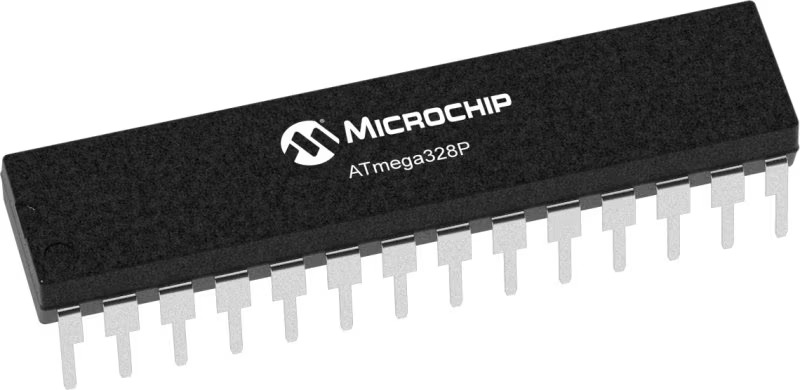
Architecture
AVR
MCU Memory (KB)
32
Silicon Vendor
Microchip
Pin count
28
RAM (Bytes)
2048
You complete me!
Accessories
Click Shield for Arduino UNO has two proprietary mikroBUS™ sockets, allowing all the Click board™ devices to be interfaced with the Arduino UNO board without effort. The Arduino Uno, a microcontroller board based on the ATmega328P, provides an affordable and flexible way for users to try out new concepts and build prototypes with the ATmega328P microcontroller from various combinations of performance, power consumption, and features. The Arduino Uno has 14 digital input/output pins (of which six can be used as PWM outputs), six analog inputs, a 16 MHz ceramic resonator (CSTCE16M0V53-R0), a USB connection, a power jack, an ICSP header, and reset button. Most of the ATmega328P microcontroller pins are brought to the IO pins on the left and right edge of the board, which are then connected to two existing mikroBUS™ sockets. This Click Shield also has several switches that perform functions such as selecting the logic levels of analog signals on mikroBUS™ sockets and selecting logic voltage levels of the mikroBUS™ sockets themselves. Besides, the user is offered the possibility of using any Click board™ with the help of existing bidirectional level-shifting voltage translators, regardless of whether the Click board™ operates at a 3.3V or 5V logic voltage level. Once you connect the Arduino UNO board with our Click Shield for Arduino UNO, you can access hundreds of Click boards™, working with 3.3V or 5V logic voltage levels.
Used MCU Pins
mikroBUS™ mapper
Take a closer look
Click board™ Schematic
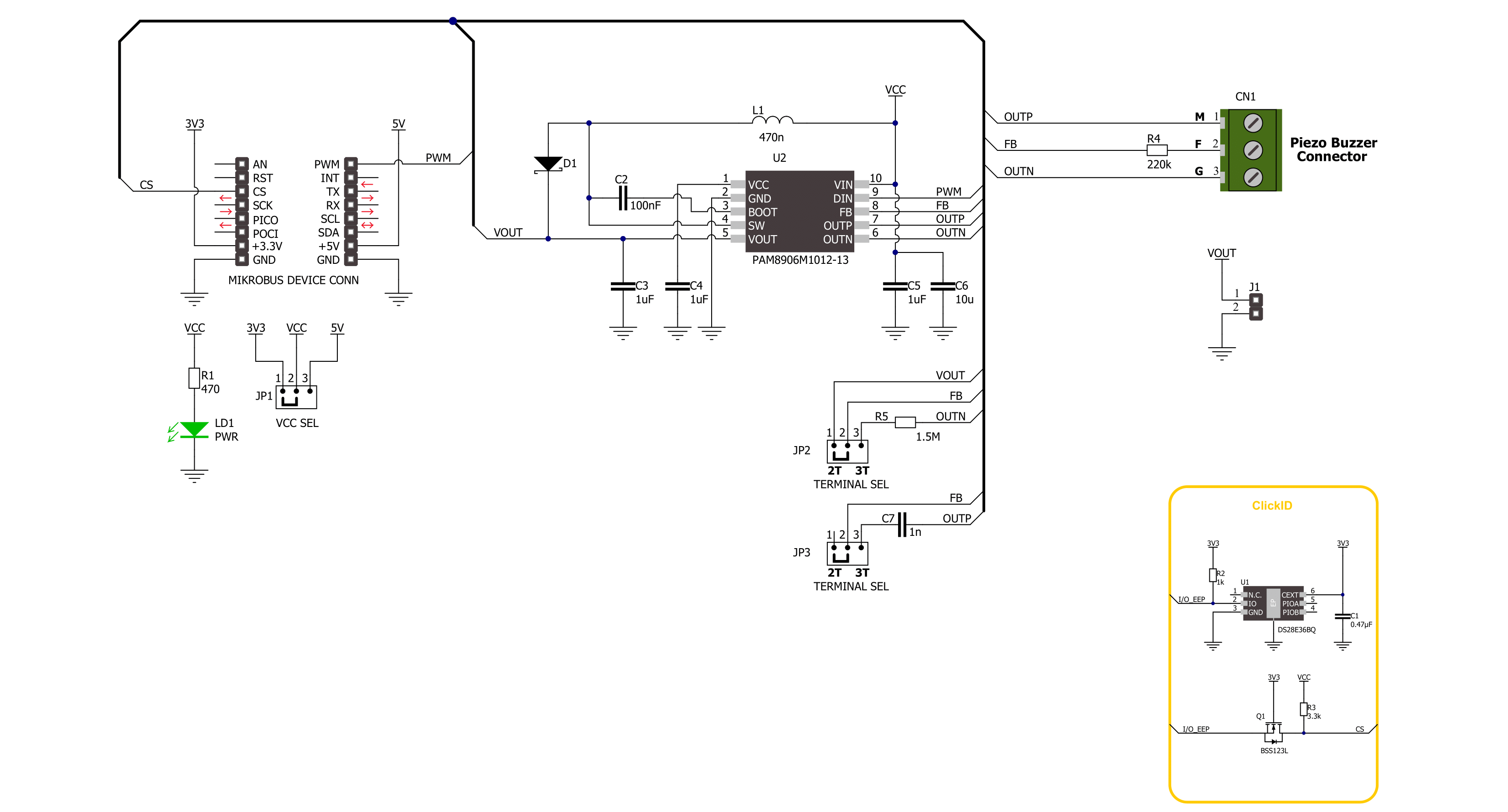
Step by step
Project assembly
Software Support
Library Description
This library contains API for Piezo Driver Click driver.
Key functions:
piezodriver_pwm_stop- Piezo Driver stop PWM module.piezodriver_pwm_start- Piezo Driver start PWM module.piezodriver_play_sound- Piezo Driver play sound function.
Open Source
Code example
The complete application code and a ready-to-use project are available through the NECTO Studio Package Manager for direct installation in the NECTO Studio. The application code can also be found on the MIKROE GitHub account.
/*!
* @file main.c
* @brief Piezo Driver Click example
*
* # Description
* This example demonstrates the use of Piezo Driver Click board.
*
* The demo application is composed of two sections :
*
* ## Application Init
* Initializes the driver and logger.
*
* ## Application Task
* Plays the Imperial March melody. Also logs an appropriate message on the USB UART.
*
* @note
* The minimal PWM Clock frequency required for this example is the frequency of tone C6 - 1047 Hz.
* In order to run this example and play all tones correctly, the user will need to decrease
* the MCU's main clock frequency in MCU Settings for certain architectures
* in order to get the required PWM clock frequency.
*
* @author Stefan Ilic
*
*/
#include "board.h"
#include "log.h"
#include "piezodriver.h"
static piezodriver_t piezodriver;
static log_t logger;
#define W 4*Q // Whole 4/4 - 4 Beats
#define H 2*Q // Half 2/4 - 2 Beats
#define Q 250 // Quarter 1/4 - 1 Beat
#define E Q/2 // Eighth 1/8 - 1/2 Beat
#define S Q/4 // Sixteenth 1/16 - 1/4 Beat
#define VOLUME 100
/**
* @brief Piezo Driver play Imperial march function.
* @details This function is used to play Imperial march on the buzzer.
* @return Nothing.
* @note None.
*/
static void imperial_march( );
void application_init ( void )
{
log_cfg_t log_cfg; /**< Logger config object. */
piezodriver_cfg_t piezodriver_cfg; /**< Click config object. */
/**
* Logger initialization.
* Default baud rate: 115200
* Default log level: LOG_LEVEL_DEBUG
* @note If USB_UART_RX and USB_UART_TX
* are defined as HAL_PIN_NC, you will
* need to define them manually for log to work.
* See @b LOG_MAP_USB_UART macro definition for detailed explanation.
*/
LOG_MAP_USB_UART( log_cfg );
log_init( &logger, &log_cfg );
log_info( &logger, " Application Init " );
// Click initialization.
piezodriver_cfg_setup( &piezodriver_cfg );
PIEZODRIVER_MAP_MIKROBUS( piezodriver_cfg, MIKROBUS_1 );
if ( PWM_ERROR == piezodriver_init( &piezodriver, &piezodriver_cfg ) )
{
log_error( &logger, " Communication init." );
for ( ; ; );
}
if ( PIEZODRIVER_ERROR == piezodriver_default_cfg ( &piezodriver ) )
{
log_error( &logger, " Default configuration." );
for ( ; ; );
}
log_info( &logger, " Application Task " );
}
void application_task ( void )
{
log_printf( &logger, "Playing the Imperial March melody ...\r\n" );
imperial_march( );
// 10 seconds delay
Delay_ms ( 1000 );
Delay_ms ( 1000 );
Delay_ms ( 1000 );
Delay_ms ( 1000 );
Delay_ms ( 1000 );
Delay_ms ( 1000 );
Delay_ms ( 1000 );
Delay_ms ( 1000 );
Delay_ms ( 1000 );
Delay_ms ( 1000 );
}
int main ( void )
{
/* Do not remove this line or clock might not be set correctly. */
#ifdef PREINIT_SUPPORTED
preinit();
#endif
application_init( );
for ( ; ; )
{
application_task( );
}
return 0;
}
static void imperial_march( )
{
piezodriver_play_sound(&piezodriver, PIEZODRIVER_NOTE_A6, VOLUME, Q );
Delay_ms ( 1 + Q );
piezodriver_play_sound(&piezodriver, PIEZODRIVER_NOTE_A6, VOLUME, Q );
Delay_ms ( 1 + Q );
piezodriver_play_sound(&piezodriver, PIEZODRIVER_NOTE_A6, VOLUME, Q );
Delay_ms ( 1 + Q );
piezodriver_play_sound(&piezodriver, PIEZODRIVER_NOTE_F6, VOLUME, E + S );
Delay_ms ( 1 + E + S );
piezodriver_play_sound(&piezodriver, PIEZODRIVER_NOTE_C7, VOLUME, S );
Delay_ms ( 1 + S );
piezodriver_play_sound(&piezodriver, PIEZODRIVER_NOTE_A6, VOLUME, Q );
Delay_ms ( 1 + Q );
piezodriver_play_sound(&piezodriver, PIEZODRIVER_NOTE_F6, VOLUME, E + S );
Delay_ms ( 1 + E + S );
piezodriver_play_sound(&piezodriver, PIEZODRIVER_NOTE_C7, VOLUME, S );
Delay_ms ( 1 + S );
piezodriver_play_sound(&piezodriver, PIEZODRIVER_NOTE_A6, VOLUME, H );
Delay_ms ( 1 + H );
piezodriver_play_sound(&piezodriver, PIEZODRIVER_NOTE_E7, VOLUME, Q );
Delay_ms ( 1 + Q );
piezodriver_play_sound(&piezodriver, PIEZODRIVER_NOTE_E7, VOLUME, Q );
Delay_ms ( 1 + Q );
piezodriver_play_sound(&piezodriver, PIEZODRIVER_NOTE_E7, VOLUME, Q );
Delay_ms ( 1 + Q );
piezodriver_play_sound(&piezodriver, PIEZODRIVER_NOTE_F7, VOLUME, E + S );
Delay_ms ( 1 + E + S );
piezodriver_play_sound(&piezodriver, PIEZODRIVER_NOTE_C7, VOLUME, S );
Delay_ms ( 1 + S );
piezodriver_play_sound(&piezodriver, PIEZODRIVER_NOTE_AB6, VOLUME, Q );
Delay_ms ( 1 + Q );
piezodriver_play_sound(&piezodriver, PIEZODRIVER_NOTE_F6, VOLUME, E + S );
Delay_ms ( 1 + E + S );
piezodriver_play_sound(&piezodriver, PIEZODRIVER_NOTE_C7, VOLUME, S );
Delay_ms ( 1 + S );
piezodriver_play_sound(&piezodriver, PIEZODRIVER_NOTE_A6, VOLUME, H );
Delay_ms ( 1 + H );
piezodriver_play_sound(&piezodriver, PIEZODRIVER_NOTE_A7, VOLUME, Q );
Delay_ms ( 1 + Q );
piezodriver_play_sound(&piezodriver, PIEZODRIVER_NOTE_A6, VOLUME, E + S );
Delay_ms ( 1 + E + S );
piezodriver_play_sound(&piezodriver, PIEZODRIVER_NOTE_A6, VOLUME, S );
Delay_ms ( 1 + S );
piezodriver_play_sound(&piezodriver, PIEZODRIVER_NOTE_A7, VOLUME, Q );
Delay_ms ( 1 + Q );
piezodriver_play_sound(&piezodriver, PIEZODRIVER_NOTE_AB7, VOLUME, E + S );
Delay_ms ( 1 + E + S );
piezodriver_play_sound(&piezodriver, PIEZODRIVER_NOTE_G7, VOLUME, S );
Delay_ms ( 1 + S );
piezodriver_play_sound(&piezodriver, PIEZODRIVER_NOTE_GB7, VOLUME, S );
Delay_ms ( 1 + S );
piezodriver_play_sound(&piezodriver, PIEZODRIVER_NOTE_E7, VOLUME, Q );
Delay_ms ( 1 + Q );
piezodriver_play_sound(&piezodriver, PIEZODRIVER_NOTE_F7, VOLUME, E );
Delay_ms ( 1 + E );
Delay_ms ( 1 + E );
piezodriver_play_sound(&piezodriver, PIEZODRIVER_NOTE_BB6, VOLUME, E );
Delay_ms ( 1 + E );
piezodriver_play_sound(&piezodriver, PIEZODRIVER_NOTE_EB7, VOLUME, Q );
Delay_ms ( 1 + Q );
piezodriver_play_sound(&piezodriver, PIEZODRIVER_NOTE_D7, VOLUME, E + S );
Delay_ms ( 1 + E + S );
piezodriver_play_sound(&piezodriver, PIEZODRIVER_NOTE_DB7, VOLUME, S );
Delay_ms ( 1 + S );
piezodriver_play_sound(&piezodriver, PIEZODRIVER_NOTE_C7, VOLUME, S );
Delay_ms ( 1 + S );
piezodriver_play_sound(&piezodriver, PIEZODRIVER_NOTE_B6, VOLUME, S );
Delay_ms ( 1 + S );
piezodriver_play_sound(&piezodriver, PIEZODRIVER_NOTE_C7, VOLUME, E );
Delay_ms ( 1 + E );
Delay_ms ( 1 + E );
piezodriver_play_sound(&piezodriver, PIEZODRIVER_NOTE_F6, VOLUME, E );
Delay_ms ( 1 + E );
piezodriver_play_sound(&piezodriver, PIEZODRIVER_NOTE_AB6, VOLUME, Q );
Delay_ms ( 1 + Q );
piezodriver_play_sound(&piezodriver, PIEZODRIVER_NOTE_F6, VOLUME, E + S );
Delay_ms ( 1 + E + S );
piezodriver_play_sound(&piezodriver, PIEZODRIVER_NOTE_A6, VOLUME, S );
Delay_ms ( 1 + S );
piezodriver_play_sound(&piezodriver, PIEZODRIVER_NOTE_C7, VOLUME, Q );
Delay_ms ( 1 + Q );
piezodriver_play_sound(&piezodriver, PIEZODRIVER_NOTE_A6, VOLUME, E + S );
Delay_ms ( 1 + E + S );
piezodriver_play_sound(&piezodriver, PIEZODRIVER_NOTE_C7, VOLUME, S );
Delay_ms ( 1 + S );
piezodriver_play_sound(&piezodriver, PIEZODRIVER_NOTE_E7, VOLUME, H );
Delay_ms ( 1 + H );
piezodriver_play_sound(&piezodriver, PIEZODRIVER_NOTE_A7, VOLUME, Q );
Delay_ms ( 1 + Q );
piezodriver_play_sound(&piezodriver, PIEZODRIVER_NOTE_A6, VOLUME, E + S );
Delay_ms ( 1 + E + S );
piezodriver_play_sound(&piezodriver, PIEZODRIVER_NOTE_A6, VOLUME, S );
Delay_ms ( 1 + S );
piezodriver_play_sound(&piezodriver, PIEZODRIVER_NOTE_A7, VOLUME, Q );
Delay_ms ( 1 + Q );
piezodriver_play_sound(&piezodriver, PIEZODRIVER_NOTE_AB7, VOLUME, E + S );
Delay_ms ( 1 + E + S );
piezodriver_play_sound(&piezodriver, PIEZODRIVER_NOTE_G7, VOLUME, S );
Delay_ms ( 1 + S );
piezodriver_play_sound(&piezodriver, PIEZODRIVER_NOTE_GB7, VOLUME, S );
Delay_ms ( 1 + S );
piezodriver_play_sound(&piezodriver, PIEZODRIVER_NOTE_E7, VOLUME, S );
Delay_ms ( 1 + S );
piezodriver_play_sound(&piezodriver, PIEZODRIVER_NOTE_F7, VOLUME, E );
Delay_ms ( 1 + E );
Delay_ms ( 1 + E );
piezodriver_play_sound(&piezodriver, PIEZODRIVER_NOTE_BB6, VOLUME, E );
Delay_ms ( 1 + E );
piezodriver_play_sound(&piezodriver, PIEZODRIVER_NOTE_EB7, VOLUME, Q );
Delay_ms ( 1 + Q );
piezodriver_play_sound(&piezodriver, PIEZODRIVER_NOTE_D7, VOLUME, E + S );
Delay_ms ( 1 + E + S );
piezodriver_play_sound(&piezodriver, PIEZODRIVER_NOTE_DB7, VOLUME, S );
Delay_ms ( 1 + S );
piezodriver_play_sound(&piezodriver, PIEZODRIVER_NOTE_C7, VOLUME, S );
Delay_ms ( 1 + S );
piezodriver_play_sound(&piezodriver, PIEZODRIVER_NOTE_B6, VOLUME, S );
Delay_ms ( 1 + S );
piezodriver_play_sound(&piezodriver, PIEZODRIVER_NOTE_C7, VOLUME, E );
Delay_ms ( 1 + E );
Delay_ms ( 1 + E );
piezodriver_play_sound(&piezodriver, PIEZODRIVER_NOTE_F6, VOLUME, E );
Delay_ms ( 1 + E );
piezodriver_play_sound(&piezodriver, PIEZODRIVER_NOTE_AB6, VOLUME, Q );
Delay_ms ( 1 + Q );
piezodriver_play_sound(&piezodriver, PIEZODRIVER_NOTE_F6, VOLUME, E + S );
Delay_ms ( 1 + E + S );
piezodriver_play_sound(&piezodriver, PIEZODRIVER_NOTE_C7, VOLUME, S );
Delay_ms ( 1 + S );
piezodriver_play_sound(&piezodriver, PIEZODRIVER_NOTE_A6, VOLUME, Q );
Delay_ms ( 1 + Q );
piezodriver_play_sound(&piezodriver, PIEZODRIVER_NOTE_F6, VOLUME, E + S );
Delay_ms ( 1 + E + S );
piezodriver_play_sound(&piezodriver, PIEZODRIVER_NOTE_C7, VOLUME, S );
Delay_ms ( 1 + S );
piezodriver_play_sound(&piezodriver, PIEZODRIVER_NOTE_AB6, VOLUME, H );
Delay_ms ( 1 + H );
}
// ------------------------------------------------------------------------ END
Additional Support
Resources
Category:Speakers




















